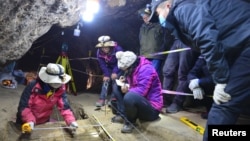Pieces of bones in a cave in the Tibetan highlands have given researchers new evidence of the mysterious human ancestors known as Denisovans.
International researchers examined more than 2,500 bones found inside Baishiya Karst Cave. Most of the bones were from animals hunted by the Denisovans. The scientists studied proteins found in the bones to learn more about the Denisovans and the animals they depended on for food.
Baishiya Karst Cave is at a high altitude, or height above sea level, of 3,280 meters in the Tibetan Plateau.
The researchers discovered that the Denisovans hunted many different kinds of animals for food including sheep and a large, hairy animal called a woolly rhinoceros. The scientists published their findings this month in Nature.
Animal resources
Most of the bones were identified as belonging to blue sheep that still live in the Himalayan Mountains. Other animals included the woolly rhinos, yaks, small mammals such as marmots, birds and the spotted hyena, a dog-like creature that lived in an area called the Ganjia Basin.
In the cave containing animal bones, the researchers also discovered a rib bone from a Denisovan individual believed to be from 48,000 to 32,000 years old. That would make it the most recent Denisovan remains yet discovered.
The researchers believe the Denisovans killed the animals for their meat. There was evidence found on the bones suggesting the cutting, or butchering, of meat and processing of animal skins. There was also evidence of animal bone tools.
Frido Welker, a molecular anthropologist with the University of Copenhagen in Denmark, was one of the leaders of the research. He said, “It is the first time we have gotten an understanding of the subsistence behaviors of Denisovans.” Welker added that these human ancestors were able to use “a wide range of animal resources.”
Dongju Zhang, an archeologist with Lanzhou University in China was another study leader. He said, “I think the diverse animal remains found in Baishiya Karst Cave suggest that this location offered relatively better resources compared with the neighboring higher Tibetan Plateau to the west and the Chinese Loess Plateau to the north…”
The Denisovans
Scientists did not publish evidence of Denisovans until 2010, when research identified a bone that came from Denisova Cave in Russia’s Siberia area. Genetic examination showed that Denisovans were closely related to Neanderthals, other human ancestors who lived in Eurasia. Both groups are believed to have interacted a lot with Homo sapiens, or modern man, and are believed to have interbred with modern humans.
Welker said, “From genetics, we know they diverged from Neanderthals around 400,000 years ago.”
Denisovans are known only from remains found in three places. They are Denisova Cave, Cobra Cave in Laos and Baishiya Karst Cave in Tibet. The wide separation suggests they lived in many different areas.
Zhang said their presence in such a wide area “implies that Denisovans had high flexibility to adapt to different environments.”
Another bone found in Baishiya Karst Cave is a lower jaw bone of a young Denisovan. It is believed to be 160,000 years old. The researchers said they thought the human ancestors lived there as early as 200,000 years ago. But the piece of rib suggests their presence was more recent.
“We don’t know if the rib was from an adult or a child, nor its genetic sex,” said Welker. He added it was the first time a Denisovan rib has ever been discovered.
Scientists say Homo sapiens did not populate the Tibetan Plateau until about 40,000 years ago and first appeared in Africa a little more than 300,000 years ago.
But what happened to the Denisovans seems to be a mystery.
“We know so little,” Welker noted, adding, “We know that Denisovans interbred with modern humans. We know that based on some Denisovan DNA that is present in the genomes of some modern humans living today.”
He then said, “But when, where and why Denisovans ultimately went extinct, that we don’t know anything about.”
I’m Mario Ritter, Jr.
Will Dunham reported this story for Reuters. Mario Ritter, Jr. adapted it for VOA Learning English.
______________________________________________
Words in This Story
anthropologist –n. a scientist who studies human race, society and behavior
subsistence –adj. related to the most basic needs for life such as food, shelter, protection and social structure
diverse –adj. involving many different kinds of related or similar things
interbreed –v. when two different species have mate and have babies
imply –v. to suggest
adapt –v. to change behavior to better meet the demands of new conditions
genome –n. to whole group of genetic information of a living thing
We want to hear from you.
Our comment policy is here.











Forum